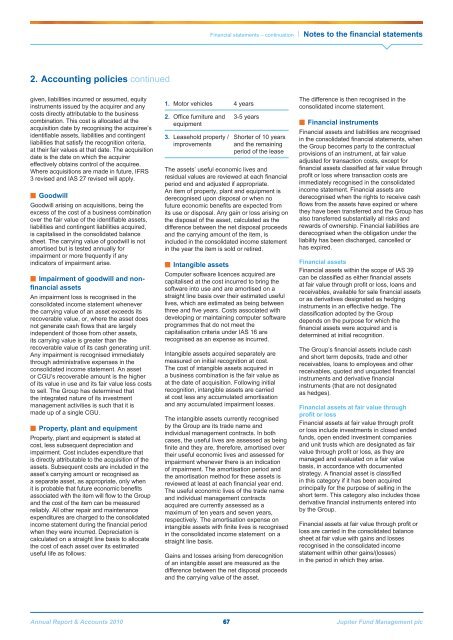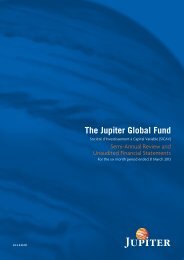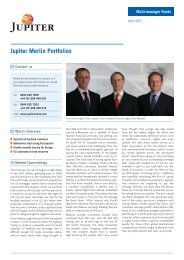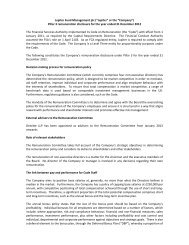Jupiter Annual Report 2010 - Jupiter Asset Management
Jupiter Annual Report 2010 - Jupiter Asset Management
Jupiter Annual Report 2010 - Jupiter Asset Management
You also want an ePaper? Increase the reach of your titles
YUMPU automatically turns print PDFs into web optimized ePapers that Google loves.
Financial statements – continuation | Notes to the financial statements<br />
2. Accounting policies continued<br />
given, liabilities incurred or assumed, equity<br />
instruments issued by the acquirer and any<br />
costs directly attributable to the business<br />
combination. This cost is allocated at the<br />
acquisition date by recognising the acquiree’s<br />
identifiable assets, liabilities and contingent<br />
liabilities that satisfy the recognition criteria,<br />
at their fair values at that date. The acquisition<br />
date is the date on which the acquirer<br />
effectively obtains control of the acquiree.<br />
Where acquisitions are made in future, IFRS<br />
3 revised and IAS 27 revised will apply.<br />
■■Goodwill<br />
Goodwill arising on acquisitions, being the<br />
excess of the cost of a business combination<br />
over the fair value of the identifiable assets,<br />
liabilities and contingent liabilities acquired,<br />
is capitalised in the consolidated balance<br />
sheet. The carrying value of goodwill is not<br />
amortised but is tested annually for<br />
impairment or more frequently if any<br />
indicators of impairment arise.<br />
■■Impairment of goodwill and nonfinancial<br />
assets<br />
An impairment loss is recognised in the<br />
consolidated income statement whenever<br />
the carrying value of an asset exceeds its<br />
recoverable value, or, where the asset does<br />
not generate cash flows that are largely<br />
independent of those from other assets,<br />
its carrying value is greater than the<br />
recoverable value of its cash generating unit.<br />
Any impairment is recognised immediately<br />
through administrative expenses in the<br />
consolidated income statement. An asset<br />
or CGU’s recoverable amount is the higher<br />
of its value in use and its fair value less costs<br />
to sell. The Group has determined that<br />
the integrated nature of its investment<br />
management activities is such that it is<br />
made up of a single CGU.<br />
■■Property, plant and equipment<br />
Property, plant and equipment is stated at<br />
cost, less subsequent depreciation and<br />
impairment. Cost includes expenditure that<br />
is directly attributable to the acquisition of the<br />
assets. Subsequent costs are included in the<br />
asset’s carrying amount or recognised as<br />
a separate asset, as appropriate, only when<br />
it is probable that future economic benefits<br />
associated with the item will flow to the Group<br />
and the cost of the item can be measured<br />
reliably. All other repair and maintenance<br />
expenditures are charged to the consolidated<br />
income statement during the financial period<br />
when they were incurred. Depreciation is<br />
calculated on a straight line basis to allocate<br />
the cost of each asset over its estimated<br />
useful life as follows:<br />
1. Motor vehicles 4 years<br />
2. Office furniture and<br />
equipment<br />
3. Leasehold property /<br />
improvements<br />
3-5 years<br />
Shorter of 10 years<br />
and the remaining<br />
period of the lease<br />
The assets’ useful economic lives and<br />
residual values are reviewed at each financial<br />
period end and adjusted if appropriate.<br />
An item of property, plant and equipment is<br />
derecognised upon disposal or when no<br />
future economic benefits are expected from<br />
its use or disposal. Any gain or loss arising on<br />
the disposal of the asset, calculated as the<br />
difference between the net disposal proceeds<br />
and the carrying amount of the item, is<br />
included in the consolidated income statement<br />
in the year the item is sold or retired.<br />
■■Intangible assets<br />
Computer software licences acquired are<br />
capitalised at the cost incurred to bring the<br />
software into use and are amortised on a<br />
straight line basis over their estimated useful<br />
lives, which are estimated as being between<br />
three and five years. Costs associated with<br />
developing or maintaining computer software<br />
programmes that do not meet the<br />
capitalisation criteria under IAS 16 are<br />
recognised as an expense as incurred.<br />
Intangible assets acquired separately are<br />
measured on initial recognition at cost.<br />
The cost of intangible assets acquired in<br />
a business combination is the fair value as<br />
at the date of acquisition. Following initial<br />
recognition, intangible assets are carried<br />
at cost less any accumulated amortisation<br />
and any accumulated impairment losses.<br />
The intangible assets currently recognised<br />
by the Group are its trade name and<br />
individual management contracts. In both<br />
cases, the useful lives are assessed as being<br />
finite and they are, therefore, amortised over<br />
their useful economic lives and assessed for<br />
impairment whenever there is an indication<br />
of impairment. The amortisation period and<br />
the amortisation method for these assets is<br />
reviewed at least at each financial year end.<br />
The useful economic lives of the trade name<br />
and individual management contracts<br />
acquired are currently assessed as a<br />
maximum of ten years and seven years,<br />
respectively. The amortisation expense on<br />
intangible assets with finite lives is recognised<br />
in the consolidated income statement on a<br />
straight line basis.<br />
Gains and losses arising from derecognition<br />
of an intangible asset are measured as the<br />
difference between the net disposal proceeds<br />
and the carrying value of the asset.<br />
The difference is then recognised in the<br />
consolidated income statement.<br />
■■Financial instruments<br />
Financial assets and liabilities are recognised<br />
in the consolidated financial statements, when<br />
the Group becomes party to the contractual<br />
provisions of an instrument, at fair value<br />
adjusted for transaction costs, except for<br />
financial assets classified at fair value through<br />
profit or loss where transaction costs are<br />
immediately recognised in the consolidated<br />
income statement. Financial assets are<br />
derecognised when the rights to receive cash<br />
flows from the assets have expired or where<br />
they have been transferred and the Group has<br />
also transferred substantially all risks and<br />
rewards of ownership. Financial liabilities are<br />
derecognised when the obligation under the<br />
liability has been discharged, cancelled or<br />
has expired.<br />
Financial assets<br />
Financial assets within the scope of IAS 39<br />
can be classified as either financial assets<br />
at fair value through profit or loss, loans and<br />
receivables, available for sale financial assets<br />
or as derivatives designated as hedging<br />
instruments in an effective hedge. The<br />
classification adopted by the Group<br />
depends on the purpose for which the<br />
financial assets were acquired and is<br />
determined at initial recognition.<br />
The Group’s financial assets include cash<br />
and short term deposits, trade and other<br />
receivables, loans to employees and other<br />
receivables, quoted and unquoted financial<br />
instruments and derivative financial<br />
instruments (that are not designated<br />
as hedges).<br />
Financial assets at fair value through<br />
profit or loss<br />
Financial assets at fair value through profit<br />
or loss include investments in closed ended<br />
funds, open ended investment companies<br />
and unit trusts which are designated as fair<br />
value through profit or loss, as they are<br />
managed and evaluated on a fair value<br />
basis, in accordance with documented<br />
strategy. A financial asset is classified<br />
in this category if it has been acquired<br />
principally for the purpose of selling in the<br />
short term. This category also includes those<br />
derivative financial instruments entered into<br />
by the Group.<br />
Financial assets at fair value through profit or<br />
loss are carried in the consolidated balance<br />
sheet at fair value with gains and losses<br />
recognised in the consolidated income<br />
statement within other gains/(losses)<br />
in the period in which they arise.<br />
<strong>Annual</strong> <strong>Report</strong> & Accounts <strong>2010</strong> 67 <strong>Jupiter</strong> Fund <strong>Management</strong> plc








